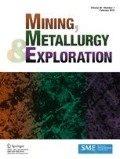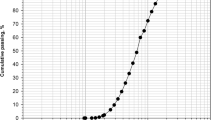Abstract
The purpose of this study was to investigate the dry grindability of calcite powders in a vertically and horizontally orientable laboratory batch type stirred mill. The experimental results were evaluated using stress intensity analysis. The performance was also compared in terms of mill orientation. The results showed that the d50 values decreased with increasing stress energy down to a certain point and then increased for both milling orientations. Even though the optimum stress energies for both vertical and horizontal orientations were in the range of 1*10−3 to 5*10−3 Nm at 750 and 1500 kJ/kg energy consumption, the product size was finer for the horizontal orientation at the same stress energy value. Additionally, to the best of the authors’ knowledge, this is the first study to compare mill orientation (vertical vs. horizontal) for the same mill and under the same test conditions.











Similar content being viewed by others
References
Kwade A (1999) Wet comminution in stirred media mills - research and its practical application. Powder Technol 105:14–20
Altun O (2013) Investigation of Dry Horizontal Stirred Milling Applications for Cement Grinding Circuits [dissertation]. Hacettepe University, Ankara, p 182
Harbort G, Hourn M, Murphy A (1998) IsaMill ultrafine grinding for a sulphide leach process. In: proceedings Auslmm 8th mill operators conference, Kalgoorlie, Australia, p. 1–6
Weller KR, Gao M (1999) Ultrafine-Grinding. [in] AJM Crushing and Grinding Conference, Kalgoorlie
Jankovic A (2003) Variables affecting the fine grinding of minerals using stirred mills. Miner Eng 16:337–345
Parry JM (2006) Ultrafine grinding for improved mineral liberation in flotation concentrates [Dissertation], University of British Columbia
Wang Y, Forssberg E (2006) Production of carbonate and silica nano-particles in stirred bead milling. Int J Miner Process 81:1–14
Kwade A (1999) Determination of the most important grinding mechanism in stirred media mills by calculating stress intensity and stress number. Powder Technol 105:382–388
Kwade A (2013) Grinding and Dispersing with Stirred Media Mills, 3. edition ed., iPAT, Braunschweig
Jankovic A (2001) Media stress intensity analysis for vertical stirred mills. Miner Eng 14:1177–1186
Edwards G, van der Westhuizen A (2014) The investigation of operating parameters in a vertical stirred mill. In: 27th International Mineral Processing Congress, IMPC, 1–11
Tüzün MA (1993) A detailed study on comminution in a vertical stirred ball mill [Dissertation], University of Nadal, South Africa
Dikmen S (2008) Modelling of The Performance of Stirred Media Mills in Regrinding Circuits [Dissertation], Hacettepe University
Kwade A, Blecher L, Schwedes J (1996) Motion and stress intensity of grinding beads in a stirred media mill. Part 2: stress intensity and its effect on comminution. Powder Technol 86:69–76
Fadhel HB, Frances C (2001) Wet batch grinding of alumina hydrate in a stirred bead mill. Powder Technol 119:257–268
Altun O, Benzer H, Enderle U (2013) Effects of operating parameters on the efficiency of dry stirred milling. Miner Eng 43-44:58–66
Gunda R, Moys MH (2015) Use of temperature for diagnosing mixing in the IsaMill. Miner Eng 73:100–108
Schulze D (2008) Powders and bulk solids, 1st edn. Springer-Verlag
Durant B, Farber BY, Rule C, Mainza A (2012) Ceramic media selection for optimization of energy efficiency in IsaMills™. Chem Eng Technol 35:1949–1953
Mucsi G, Rácz Á, Mádai V (2013) Mechanical activation of cement in stirred media mill. Powder Technol 235:163–172
Rácz Á, Csőke B (2016) Application of the product related stress model for product dispersity control in dry stirred media milling. Int J Miner Process 157:28–35
Rácz A (2014) Reduction of surface roughness and rounding of limestone particles in a stirred media mill. Chem Eng Technol 37:865–872
Kwade A (2003) A stressing model for the description and optimization of grinding processes. Chem Eng Technol 26:199–205
Rydin RW, Maurice D, Courtney TH (1993) Milling dynamics: part I. Attritor dynamics: results of a cinematographic study. Metall Trans A 24:175–185
Barley RW, Conway-Baker J, Pascoe RD, Kostuch J, McLoughlin B, Parker DJ (2004) Measurement of the motion of grinding media in a vertically stirred mill using positron emission particle tracking (PEPT) part II. Miner Eng 17:1179–1187
Pinkney SZR, Riley M, Rowson NA, Blackburn S, Skuse D (2013) Positron Emission Particle Tracking In A Vertical Stirred Media Mill. [in] 23rd World Mining Congress, Montreal, Canada
Jayasundara C, Yang R, Yu A, Curry D (2006) Discrete particle simulation of particle flow in the IsaMill process. Ind Eng Chem Res 45:6349–6359
van der Westhuizen AP, Govender I, Mainza AN, Rubenstein J (2011) Tracking the motion of media particles inside an IsaMill™ using PEPT. Miner Eng 24:195–204
Blecher L, Kwade A, Schwedes J (1996) Motion and stress intensity of grinding beads in a stirred media mill. Part 1 : Energy density distribution and motion of single grinding beads. Powder Technol 86:59–68
Acknowledgments
The authors would like to thank Micron’S Company (Nigde, Turkey) for providing the sample, and Niğde Ömer Halisdemir University Scientific Research Projects Directorate (Project No. FEB2016/23 BAGEP) for funding this research.
A special thanks to Prof. Aubrey Mainza (University of Cape Town) for all contributions.
Author information
Authors and Affiliations
Contributions
Serkan CAYIRLI: Conceptualization, methodology, formal analysis, investigation, project administration, funding acquisition, writing.
H. Serkan GOKCEN: Conceptualization, methodology, formal analysis, investigation, writing, review and editing.
Corresponding author
Ethics declarations
Conflict of Interest
The authors declare that they have no conflict of interest.
Additional information
Publisher’s Note
Springer Nature remains neutral with regard to jurisdictional claims in published maps and institutional affiliations.
Rights and permissions
About this article
Cite this article
Cayirli, S., Gokcen, H.S. The Influence of Stirred Mill Orientation on Calcite Grinding. Mining, Metallurgy & Exploration 38, 1551–1560 (2021). https://doi.org/10.1007/s42461-021-00426-7
Received:
Accepted:
Published:
Issue Date:
DOI: https://doi.org/10.1007/s42461-021-00426-7




